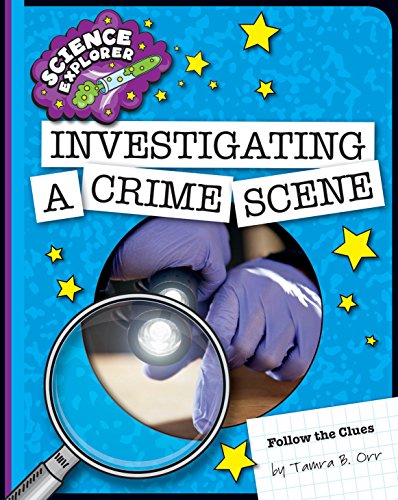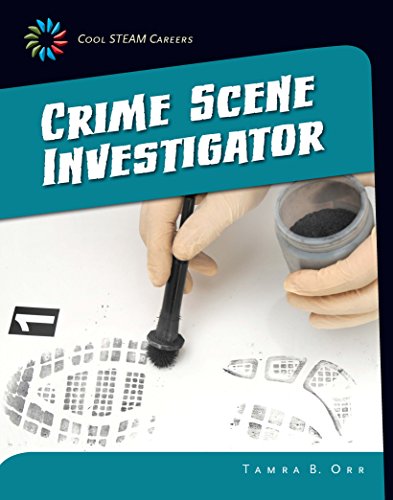-
Brain Games - Crime Scene Investigation
Publications International Ltd.
Spiral-bound (Publications International, Ltd., April 1, 2017)Use your verbal, visual, and logic skills to investigate 150+ puzzles!This puzzle collection contains a mix of verbal and visual puzzles themed around crime scene investigation. Match fingerprints, see what you remember about crime scenes, detect visual anomalies, solve verbal puzzles related to crime, and search for solutions.
-
Brain Games - Crime Scene Investigation
Publications International Ltd.
Spiral-bound (Publications International, Ltd., April 1, 2019)Use your verbal, visual, and logic skills to investigate an array of puzzles! This CSI puzzle collection contains a mix of verbal and visual puzzles themed around crimes and investigation. Examine photos of crime scenesSolve verbal puzzles related to crimeCrack passwordsRead about true crime accounts and see how much you rememberUse logic to track down criminals and find witnessesSpiral bound192 pages
-
An Introduction to Crime Scene Investigation
Aric W. Dutelle
Paperback (Jones & Bartlett Learning, Feb. 2, 2016)In a world heavily influenced by popular forensic television dramas, the real-life duties and complexities involved in crime scene investigation are often misrepresented and misunderstood. An Introduction to Crime Scene Investigation, Third Edition is a comprehensive and accurate overview of the practical application of forensic science in crime scene investigation. Focusing on the day-to-day aspects, this full-color text describes the methodologies and technologies employed by crime scene personnel, and pushes the reader to identify the interrelated components of the investigative process.Recognizing the importance of those who have contributed to and advanced the field of forensic science, the reader is introduced to crime scene investigation through a historical perspective. The updated Third Edition covers components not typically found in many crime scene texts, including ethical considerations and public misconceptions of the investigative process―the so-called “CSI Effect.” Extensive discussion of physical evidence examination and analysis is provided, including the forensic potential of physical evidence, crime scene procedures, and what evidence should be documented, collected, and preserved. Real-life examples over 250 detailed, full-color photos and figures enhance comprehension and demonstrate specific strategies for technique applicationWhile the vast majority of the text is written with an American audience in mind, the author has chosen to call upon his significant international experience and include cases, information, and photographs/figures which are external to the United States.Examples of these include: Photographs from Honduras, France, Haiti and Uganda. Ripped from the headlines involve cases which occur in or discuss: Canada, Germany, Italy, Pakistan, Mexico, Brazil, Russia, Yemen and Spain Historical development of CSI incorporates India, Japan, Great Britain, France, Canada, Argentina and China Sources of reference originate from: Canada, Great Britain, France, Germany and AustraliaWhile the specific laws discussed refer to American courts and decisions, the science and methodologies are ones which are recognized as best-practices around the globe, as pertains to the scientific investigation of crime scenes.An Introduction to Crime Scene Investigation, Third Edition is an invaluable reference and essential educational resource.
-
Techniques of Crime Scene Investigation
Barry A. J. Fisher, David R. Fisher
Hardcover (CRC Press, June 15, 2012)"If you are a Professional Crime Scene Investigator, then this book is a must have for both your personal forensic reference library, as well as your office reference library." ―Edward W. Wallace Jr., Certified Senior Crime Scene Analyst, Retired First Grade Detective, NYPD"Techniques of Crime Scene Investigation is a well-written, comprehensive guide to the investigative and technical aspects of CSI. The textbook is an educational standard on the theory and practice of crime scene investigation and includes many informative casework examples and photographs. On reading this book, students, entry-level personnel, and experienced practitioners will have a better understanding of the strengths and limitations of forensic science in its application to crime scene investigations." ―Professor Don Johnson, School of Criminal Justice and Criminalistics, California State University, Los AngelesThe application of science and technology plays a critical role in the investigation and adjudication of crimes in our criminal justice system. But before science can be brought to bear on evidence, it must be recognized and collected in an appropriate manner at crime scenes. Written by authors with over 50 years of combined experience in forensic science, Techniques of Crime Scene Investigation examines the concepts, field-tested techniques, and procedures of crime scene investigation. Detectives, crime scene technicians, and forensic scientists can rely on this updated version of the "forensics bible" to effectively apply science and technology to the tasks of solving crimes. What’s New in the Eighth Edition: The latest in forensic DNA testing and collection, including low copy number DNA A new chapter on digital evidence New case studies with color photographs End-of-chapter study questions Practical tips and tricks of the trade in crime scene processing
-
Investigating a Crime Scene
Tamra B. Orr
eBook (Cherry Lake Publishing, Dec. 13, 2013)The ability to use the scientific method is key to carrying out experiments, taking measurements, or performing technical tasks. In this book, readers in real-world situations are tasked with following clues and using the scientific method to find out what happens during a crime scene investigation. Informational text presents evidence and facts in the form of clues and side-bar details to help children develop critical thinking skills. A summary of the situation is included to show how each chapter contributes to the whole and for a solid understanding of the topic.
-
Crime Scene Investigation
Colin Evans, Consulting Editor John L. F Colin Evans
language (Chelsea House Publications, Feb. 1, 2009)This title details the emergence of modern crime-fighting techniques from the mid-1800s to the present, focusing on how crime scenes are treated, how evidence is processed, and how evidence is used in court to build a case for conviction.
-
Complete Crime Scene Investigation Handbook
Everett Baxter Jr.
Hardcover (CRC Press, May 20, 2015)Crime scene investigators are the foundation for every criminal investigation. The admissibility and persuasiveness of evidence in court, and in turn, the success of a case, is largely dependent upon the evidence being properly collected, recorded, and handled for future analysis by investigators and forensic analysts in the lab. Complete Crime Scene Investigation Handbook is the most complete, one-stop practical reference for law enforcement and crime scene professionals as well as students looking to enter the field. The book provides step-by-step methods and best practice protocols for effectively finding, recognizing, recording, collecting, preserving, handling, and packaging evidence. With more than 650 full color photos and illustrations the book covers: The investigative team and its responsibilities The rules for forensic search and seizure Proper documentation of evidence via note-taking, photography, and sketching Search patterns and the special considerations for various searches The use of alternative light sources Presumptive tests via luminol and other methods Latent fingerprint processing Evidence collection and packaging Serological, trace, firearms, toolmark, footwear, tire, and digital evidence Injury documentation Appendices with a full compliment of sample forms, equipment lists, and checklists to assist in crime scene investigation A special considerations section reviews topics such as shooting scene and bloodstain documentation, clandestine graves and scattered human remains, fire scenes, and questioned document evidence. The final chapters examine how to develop a working plan and processing methodology as well as effective report writing. This book is a must-have reference for experienced forensic, crime scene, and investigative professionals as well as students in forensic science programs looking to enter the field.A specially developed companion lab exercise workbook―The Complete Crime Scene Investigation Workbook (ISBN: 978-1-4987-0142-6)―is also available for purchase and can be used in conjunction with this handbook, both for group training purposes or for individuals looking for hands-on self-study.
-
Crime Scene Investigator
Tamra B. Orr
language (Cherry Lake Publishing, Sept. 15, 2015)Readers will learn what it takes to succeed as a crime scene investigator. The book also explains the necessary educational steps, useful character traits, potential hazards, and daily job tasks related to this career. Sidebars include thought-provoking trivia. Questions in the backmatter ask for text-dependent analysis. Photos, a glossary, and additional resources are included.
-
Complete Crime Scene Investigation Workbook
Everett Baxter Jr.
Paperback (CRC Press, May 21, 2015)This specially developed workbook can be used in conjunction with the Complete Crime Scene Investigation Handbook (ISBN: 978-1-4987-0144-0) in group training environments, or for individuals looking for independent, step-by-step self-study guide. It presents an abridged version of the Handbook, supplying both students and professionals with the most critical points and extensive hands-on exercises for skill enhancement. Filled with more than 350 full-color images, the Complete Crime Scene Investigation Workbook walks readers through self-tests and exercises they can perform to practice and improve their documentation, collection, and processing techniques.Most experienced crime scene investigators will tell you that it is virtually impossible to be an expert in every aspect of crime scene investigations. If you begin to "specialize" too soon, you risk not becoming a well-rounded crime scene investigator. Establishing a complete foundation to the topic, the exercises in this workbook reinforce the concepts presented in the Handbook with a practical, real-world application.As a crime scene investigator, reports need to be more descriptive than they are at the patrol officer level. This workbook provides a range of scenarios around which to coordinate multiple exercises and lab examples, and space is provided to write descriptions of observations. The book also supplies step-by-step, fully illustrative photographs of crime scene procedures, protocols, and evidence collection and testing techniques. This lab exercise workbook is ideal for use in conjunction with the Handbook, both in group training settings, as well as a stand-alone workbook for individuals looking for hands-on self-study. It is a must-have resource for crime scene technicians, investigators, and professionals who want a complete manual of crime scene collection and processing techniques.
-
Investigating a Crime Scene
Tamra B Orr
Paperback (Cherry Lake Pub, Jan. 1, 2014)The ability to use the scientific method is key to carrying out experiments, taking measurements, or performing technical tasks. In this book, readers in real-world situations are tasked with following clues and using the scientific method to find out what happens during a crime scene investigation. Informational text presents evidence and facts in the form of clues and side-bar details to help children develop critical thinking skills. A summary of the situation is included to show how each chapter contributes to the whole and for a solid understanding of the topic. Y
Y
-
Criminal Investigation
Charles Swanson, Neil Chamelin, Leonard Territo, Robert W Taylor
Hardcover (McGraw-Hill Education, May 14, 2008)Widely recognized as the most accurate and comprehensive text in the field, this practical, step-by-step introduction to criminal investigation gives students a logical framework for understanding the investigative process. Major sections cover current issues such as environmental crime, the looting of archaeological sites, videotaping of crime scenes, street gangs, and drugs. Case studies throughout the text emphasize the applied technique of criminal investigation. Graphs, charts, and arresting photographs found throughout the text depict the practical aspects of investigation and help to clarify difficult scientific concepts. The tenth edition has been significantly updated with new content to reflect new statistical data, technology, procedures, and law.
-
Criminal Investigation
Charles Swanson, Neil Chamelin, Leonard Territo, Robert W. Taylor
Hardcover (McGraw-Hill Companies, Aug. 16, 2006)An important contribution to the law enforcement field at every level Criminal Investigation is recognized as the most accurate, comprehensive, and practical book in its field. This updated edition examines the latest investigative methods and technologies with new information on white-collar crime, drugs, terrorism, and homeland security.The simulation CD contains interactive modules covering the investigative process.